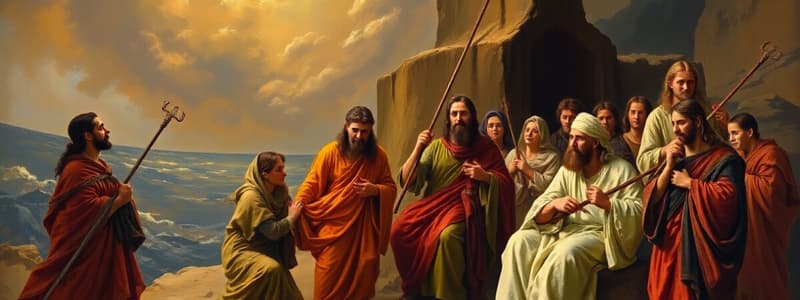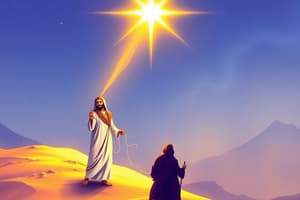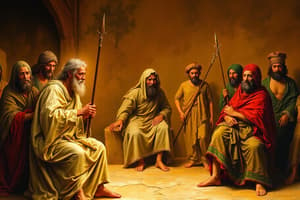Podcast
Questions and Answers
How does the book of Exodus primarily depict the origin of Israel?
How does the book of Exodus primarily depict the origin of Israel?
- As a nomadic tribe settling into agricultural life.
- As a nation born out of divine promise and liberation. (correct)
- As a priestly nation under the direct rule of God.
- As a kingdom established through military conquest.
What is the significance of the annual Passover celebration mandated in Exodus?
What is the significance of the annual Passover celebration mandated in Exodus?
- To celebrate the giving of the Ten Commandments.
- To commemorate the completion of the tabernacle.
- To annually remember the exodus from Egypt and God's supernatural direction. (correct)
- To remember the construction of the golden calf.
Which of the following theological interpretations is supported by the manna provided to the Israelites in the wilderness, according to the content?
Which of the following theological interpretations is supported by the manna provided to the Israelites in the wilderness, according to the content?
- Highlights the temporary nature of God's blessings.
- Represents the need for physical sustenance alone.
- Symbolizes God's provision through Jesus, sustaining spiritual life. (correct)
- Indicates the importance of self-reliance and hard work.
What was the primary implication of Moses breaking the stone tablets inscribed with the Ten Commandments upon witnessing the golden calf?
What was the primary implication of Moses breaking the stone tablets inscribed with the Ten Commandments upon witnessing the golden calf?
According to Exodus, what role did Bezalel play in the construction of the tabernacle, and where did the design come from?
According to Exodus, what role did Bezalel play in the construction of the tabernacle, and where did the design come from?
What does the content suggest about the theological significance of the rock that Moses struck to produce water?
What does the content suggest about the theological significance of the rock that Moses struck to produce water?
In what context does the content present the 'Jethro principle,' and what does it signify?
In what context does the content present the 'Jethro principle,' and what does it signify?
How does the content frame the relationship between the physical deliverance from Egypt and spiritual salvation?
How does the content frame the relationship between the physical deliverance from Egypt and spiritual salvation?
Which aspect of God's interaction with Moses after the golden calf incident emphasizes divine mercy despite divine justice?
Which aspect of God's interaction with Moses after the golden calf incident emphasizes divine mercy despite divine justice?
What does the requirement for the Israelites to gather silver and gold from the Egyptians immediately before the final plague indicate about God’s plan?
What does the requirement for the Israelites to gather silver and gold from the Egyptians immediately before the final plague indicate about God’s plan?
How might the multiple instances of Israel's complaining in Exodus function as a narrative device?
How might the multiple instances of Israel's complaining in Exodus function as a narrative device?
How does the content connect the symbolism of the slain lamb in Exodus to Christian theology?
How does the content connect the symbolism of the slain lamb in Exodus to Christian theology?
What does the shining of Moses' face after receiving the commandments signify within the narrative?
What does the shining of Moses' face after receiving the commandments signify within the narrative?
What is the key difference between the initial appointment of Aaron and the subsequent selection of the tribe of Levi for priesthood, as detailed in Exodus?
What is the key difference between the initial appointment of Aaron and the subsequent selection of the tribe of Levi for priesthood, as detailed in Exodus?
How does the content interpret God’s warning against making covenants with the inhabitants of the Promised Land?
How does the content interpret God’s warning against making covenants with the inhabitants of the Promised Land?
What theological concept is emphasized by God providing a second set of stone tablets after the first set was broken?
What theological concept is emphasized by God providing a second set of stone tablets after the first set was broken?
According to the content, what is the primary significance of the three required feasts (Passover, Unleavened Bread, Harvest/Ingathering) as mandated in Exodus?
According to the content, what is the primary significance of the three required feasts (Passover, Unleavened Bread, Harvest/Ingathering) as mandated in Exodus?
What aspect of Moses’ intercession for Israel after the golden calf incident is described as unprecedented, according to the content?
What aspect of Moses’ intercession for Israel after the golden calf incident is described as unprecedented, according to the content?
In what way does the construction of the tabernacle in Exodus serve to establish a new paradigm for worship?
In what way does the construction of the tabernacle in Exodus serve to establish a new paradigm for worship?
How does the content interpret the Israelites leaving Egypt in “orderly ranks”?
How does the content interpret the Israelites leaving Egypt in “orderly ranks”?
Flashcards
What is Exodus?
What is Exodus?
The second book of the Pentateuch.
What 'Exodus' means.
What 'Exodus' means.
Exit or departure, relating to Israel's departure from Egypt.
Chapter 8 of Exodus
Chapter 8 of Exodus
The plagues of frogs, lice, and flies.
Chapter 9 of Exodus
Chapter 9 of Exodus
Signup and view all the flashcards
Chapter 10 of Exodus
Chapter 10 of Exodus
Signup and view all the flashcards
Chapter 12 of Exodus
Chapter 12 of Exodus
Signup and view all the flashcards
Chapter 13 of Exodus
Chapter 13 of Exodus
Signup and view all the flashcards
Chapter 14 of Exodus
Chapter 14 of Exodus
Signup and view all the flashcards
Exodus 15-17
Exodus 15-17
Signup and view all the flashcards
Exodus 19
Exodus 19
Signup and view all the flashcards
Exodus 20
Exodus 20
Signup and view all the flashcards
Exodus 21-22
Exodus 21-22
Signup and view all the flashcards
Exodus 23
Exodus 23
Signup and view all the flashcards
Exodus 24
Exodus 24
Signup and view all the flashcards
Exodus 25-30
Exodus 25-30
Signup and view all the flashcards
Who is Bezalel?
Who is Bezalel?
Signup and view all the flashcards
Exodus 32
Exodus 32
Signup and view all the flashcards
Exodus 33-34
Exodus 33-34
Signup and view all the flashcards
Exodus 35-40
Exodus 35-40
Signup and view all the flashcards
Jesus
Jesus
Signup and view all the flashcards
Study Notes
- The book of Exodus is the second book of the Pentateuch.
- The Hebrews called the book of Exodus, "And These Are The Names."
- The book of Exodus is divided into forty chapters.
- This book reveals the events surrounding the birth of Israel as a nation.
- "Exodus" means exit or departure, relating to Israel's departure from Egypt.
- This departure can be compared to salvation from sin and death.
- Chapter one tells of the multiplication of the descendants of Jacob and their oppression after the deaths of Joseph and his contemporaries.
- Chapters two and three record the birth, growth, escape, and commission of Moses.
- Chapter four reveals Moses' commission by God to deliver the Israelites from bondage.
- It also covers Moses' resistance.
- It includes the signs God gave to Moses.
- It mentions Aaron's appointment as Moses' spokesman.
- It comprises the circumcision of Moses' son, Moses and Aaron's return to Egypt, and their acceptance by the elders of Israel.
- Chapter five tells of Moses' request to Pharaoh for the release of the Israelites to worship God.
- It covers Pharaoh's unfavorable response.
- It documents Israel's rejection of Moses, and Moses' questioning of God.
- Chapter six tells of God's plan for Israel's release.
- It comprises Moses' instructions to speak to Pharaoh.
- it states the identity of Israel's descendants by families.
- Chapter seven gives the account of Moses' reassurance by God.
- It features Aaron's rod becoming a serpent.
- It entails the waters being turned to blood.
- Chapter eight describes the plagues of the frogs, lice, and flies.
- Chapter nine reports the plagues of pestilence on the beast.
- It indicates boils on both man and beast.
- It notes the destruction caused by hail.
- God's distinction between the Israelites and the Egyptians is stated.
- Chapter ten describes the plagues of locusts and darkness.
- Chapter eleven announces the coming plague of death.
- It documents God's instructions for the children of Israel to gather silver and gold from the Egyptians.
- Chapter twelve gives an account of the first Passover.
- It covers the death of the Egyptians' firstborn.
- It accounts for the exodus of Israel from Egypt.
- The opposition that Moses faced while trying to carry out the mandate of God serves as an example.
- God's commissions and mandates must never be judged by opposition or lack of it.
- Chapter thirteen documents Israel's new beginning.
- It covers the mandate to annually celebrate the Passover and the feast of Unleavened bread.
- It includes God's supernatural direction.
- The children of Israel left Egypt in “orderly ranks."
- They carried Joseph's bones out of Egypt, as he had requested.
- God declared the day of Israel's exodus as the beginning of the year.
- This new beginning of Israel can be compared to the new birth of the believer, who dies to sin and lives for Jesus.
- Chapter fourteen records the beginning of Israel's journey.
- It includes Pharaoh's change of heart.
- It entails Israel's complaint.
- It accounts for the destruction of Pharaoh's army.
- Israel responded to her first opposition by complaining.
- Despite Israel's complaint, God delivered the Israelites and destroyed the Egyptians through the “Red Sea” experience.
- Chapters fifteen through seventeen tell of Israel's complaints and God's intervention.
- Chapter fifteen documents Israel's song of deliverance.
- It also records Israel's second complaint and God's intervention.
- The bitter water was made sweet.
- In chapter sixteen, Israel complains again, and God supernaturally provides manna.
- The manna given by God to sustain the physical lives of the Israelites can be compared to Jesus, Who sustains our life. (Matthew 4:4)
- Both the manna and Jesus came down out of heaven from God. (John 6:32-33)
- Just as the manna was Israel's daily provision, Jesus is the daily provision of the believer. (Matthew 6:11; John 6:35)
- Chapter seventeen tells of Israel's complaint of lack of water and the provision of water that came as a result of Moses striking the rock.
- According to I Corinthians 10:4, the rock symbolizes Jesus, Who quenches our thirst.
- (John 4:10; John 7:37)
- The smiting of the rock points to the provisions that came as a result of the smiting (death-burial-resurrection) of Jesus.
- Chapter seventeen also records the defeat of Amalek as a result of Moses, Aaron, Hur, and Joshua each doing his part.
- Chapter eighteen gives insight into the legitimacy of delegated authority.
- This delegated authority is often referred to as the “Jethro principle.”
- Chapters nineteen through thirty-one reveal God's covenant, the constitution for the nation of Israel, and the plan and order for worshipping God.
- In chapter nineteen, God offers the priesthood to the entire nation of Israel.
- Chapter twenty documents the “Ten Commandments."
- Chapters twenty-one and twenty-two deal with civil laws.
- Chapter twenty-three emphasizes justice, the Sabbatical year, the three required feasts (Passover/Unleavened Bread-Harvest-Ingathering), and the importance of obeying the angel of the Lord.
- In chapter twenty-four, Moses ratifies the covenant by reading the Book of the Covenant and sprinkling blood on both the book and the people.
- Moses was commanded by God to come up the mountain to receive the law and commandments written in stone.
- Moses was on the mountain (Sinai/Horeb) forty days and forty nights.
- While on the mount, Moses received the pattern from God to make the tabernacle and everything that pertained to it.
- Moses was instructed to make Aaron, his brother, the high priest.
- Chapters twenty-five through thirty give detailed descriptions for the tabernacle, its framework and coverings, the ark of the covenant, the altar of incense, the lampstand, the table of showbread, the laver, the brazen altar, the garments of the priests, the anointing oil, the incense, and the consecration ceremony for the tabernacle and priests.
- In chapter thirty one, God appointed Bezalel to oversee the construction of the tabernacle and all its items
- The revelation of the tabernacle was given unto Moses, not Bezalel, though Bezalel was appointed to oversee its construction
- God's appointment of Bezalel was conveyed to Moses, who actually appointed him to oversee the building of the tabernacle.
- The pattern for all the items to be built was revealed to Moses, not Bezalel.
- Moses had to convey accurately the pattern that he had seen so that Bezalel could implement the construction of each item to specification.
- Instructions concerning the Sabbath are reiterated in chapter thirty-one.
- After receiving the instructions of God, Moses was given two tables of stone written by God, Himself.
- Chapter thirty-two records the sin of Israel and Aaron regarding the golden calf, which was made while Moses was on Mount Sinai.
- The sin of Israel was revealed to Moses by God before he left the mountain. (Exodus 32:7-8)
- Had Moses not interceded for Israel, God would have completely destroyed them. (Exodus 32:9-14)
- When Moses saw the golden calf and the actions of the people, he threw the commandments to the ground, breaking them. (Exodus 32:19-20)
- During this time of rebellion, the tribe of Levi was chosen for priesthood because of their zeal for the Lord. (Exodus 32:26-28)
- Moses made unprecedented intercession when he asked God to forgive Israel or else blot his (Moses') name out of His book. (Exodus 32:31-33)
- Chapters thirty-three and thirty-four record conversation between God and Moses and the rewriting of the Ten Commandments after the incident with the golden calf.
- God commanded Moses to depart from their location, assuring him that He would send His angel before him.
- God told Moses that He would not go up in their midst, lest He consume them because of their stubbornness.
- God honored Moses' request “to know His way" and literally revealed Himself to Moses. (Exodus 33:13-23)
- Moses provided the second set of stones upon which God wrote the commandments. (Exodus 34:1)
- God warned Moses against making a covenant with the inhabitants of the Promised Land. (Exodus 34:12)
- God reiterated the mandate for attending the three required feasts (Passover/Unleavened Bread-Harvest/Pentecost-Ingathering/Tabernacles).
- When Moses returned from talking with God, the skin of his face was shining so brightly that he had to cover his face to talk with the people. (Exodus 34:29-35)
- Chapters thirty-five through forty record Moses' appeal for materials to build the tabernacle, the response of the people, the building of the tabernacle and its accessories, and setting up the tabernacle for worship.
- The Christ of Exodus is the Deliverer, Supplier, and Passover.
- According to I Corinthians 10:4, Jesus was the “Rock" from which the water came forth in the wilderness.
- In John 6:33, Jesus declares Himself to be the Bread of God Who comes down from heaven and gives life.
- The blood of the slain lamb is symbolic of Jesus, who was slain to take away the sin of the world and whose blood must be applied the doorposts of hearts.
Studying That Suits You
Use AI to generate personalized quizzes and flashcards to suit your learning preferences.



